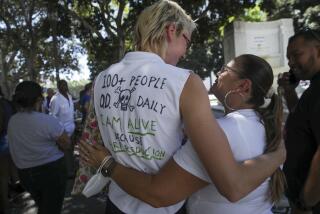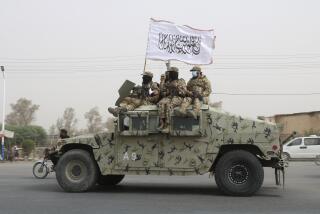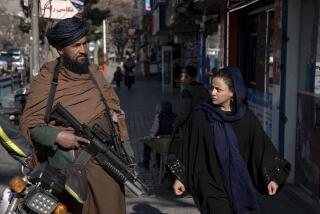New U.S. tactics said to reduce Afghan civilian deaths
- Share via
KABUL, AFGHANISTAN — Western troops have killed far fewer Afghan civilians since the top U.S. general imposed strict new rules of engagement aimed at addressing one of the most contentious issues of the conflict, according to newly declassified U.S. military figures.
However, the data cover a relatively short period of eight weeks, and make it clear that civilians are still dying in large numbers, a pattern blamed in part on the Taliban’s campaign of violence surrounding last week’s national elections.
The toll on civilians has angered Afghanistan’s government and poisoned public opinion against the presence of American and allied troops. The Obama administration has made reducing such deaths a top priority for the U.S. military.
The period since the new rules took effect have also coincided with some of the heaviest losses of the war for Western forces. But military spokesmen deny any link, saying record fatalities were caused by the summer’s troop buildup and an accompanying push into areas controlled by the Taliban, rather than any greater hazard to troops posed by the new rules.
According to the latest figures from the North Atlantic Treaty Organization, coalition forces were responsible for 19 civilian deaths from the beginning of July until Thursday, as opposed to 249 caused by insurgents. During roughly the same period a year earlier, Western forces caused 151 civilian deaths, by their own count -- not far short of the 210 deaths caused by militants.
The new NATO data, however, cover a relatively short period in the context of an 8-year-old war.
Military officials credit the marked decrease to a tactical directive issued July 2 by Gen. Stanley A. McChrystal, who assumed overall command of NATO and U.S. forces in Afghanistan in mid-June.
McChrystal said commanders could take measures needed for self-defense, but ordered them to break off engagements with Taliban fighters rather than pursuing them if civilians would be endangered by calling in artillery or airstrikes.
“We must fight the insurgents,” McChrystal wrote in the directive. “But we will not win based on the number of Taliban we kill, but instead on our ability to separate insurgents from the center of gravity, the people. . . . That means we must respect and protect the population.”
In the past, large-scale civilian deaths were most often caused by airstrikes. But now, after the new directive, airstrikes are used much less frequently, said Brig. Gen. Eric Tremblay, a Canadian who serves as chief spokesman for the International Security Assistance Force.
He said the use of “close air support” -- fire from warplanes in support of ground troops -- had fallen significantly. It had been an element in about 30% to 40% of major clashes, but that figure has dropped to about 10%, he estimated.
The message of the tactical directive was that “force needs to be applied, but carefully,” Tremblay said.
The tallying of civilian deaths in a conflict can be difficult and sometimes controversial. Disagreements over a single major incident can skew the count.
In early May, for instance, the Afghan government said about 140 civilians were killed in American airstrikes in the village of Garani, in western Afghanistan. U.S. forces put the number of dead at less than half that and said most of those killed were insurgents.
Even before arriving in the country, McChrystal told U.S. lawmakers and NATO allies that civilian deaths were seriously jeopardizing the war effort by inflaming Afghan anger against foreign forces. He promised to make safeguarding civilians his top priority.
The United Nations mission in Afghanistan, which has repeatedly appealed to both sides to make efforts to stem civilian deaths and injuries, said it could not corroborate the latest military figures. But the world body had welcomed the new rules of engagement for Western troops.
“The challenge that the military faces is ensuring that these rules filter down to troops on the ground, and we know that Gen. McChrystal is driving it down to that level,” said Aleem Siddique, a U.N. spokesman.
A U.N. report on civilian casualties in the first half of 2009 says that more than 1,000 civilians were killed, an increase of about 25% from the first half of 2008. Insurgents were blamed for about 60% of those deaths, and coalition forces for about 30%, with responsibility unclear in the remaining cases. A U.N. compilation that will cover the late-summer months is due in September.
Over the last year, Afghan President Hamid Karzai has complained repeatedly about civilian deaths, and he made the subject a centerpiece of his presidential campaign. The votes in the Aug. 20 balloting are still being tallied, with a partial count putting Karzai ahead of his main rival, former Foreign Minister Abdullah Abdullah, but not over the 50% threshold he would need to avoid a runoff.
A senior Afghan government official, speaking on condition of anonymity because he had not yet seen the military figures, said he welcomed any decrease in civilian deaths, but noted that Western tallies do not always match those of Afghan authorities.
For civilians and Western troops alike, one of the main hazards is roadside bombs planted by insurgents. They account for the vast majority of military fatalities and a major share of civilian deaths. Civilians also tend to take the brunt of suicide bombings, which are often aimed at official installations and the security forces.
Many Afghan civilians, inured by suffering, have stopped making a distinction between deaths caused by coalition troops and insurgents.
“It is the common people caught between the Taliban and foreigners who suffer,” said Mohammed Noor, a chicken vendor in Kandahar who lost four members of his family this week in massive vehicle bombings in the southern city. That attack killed more than 40 people.
The number of American soldiers who have died in Afghanistan this month reached 44 on Thursday, officials said, when a U.S. service member was killed in an attack in southern Afghanistan involving a roadside bomb and gunfire. A total of 45 soldiers died in July, which was the most lethal month for American forces in Afghanistan since the U.S.-led invasion in 2001, according to the website icasualties.org.
Over the summer, thousands of American troops have been deployed in the south in Helmand and Kandahar provinces, which are considered among the most dangerous parts of the country. Until recently, Taliban fighters had free rein in many parts of the two provinces, which are also centers of Afghanistan’s drug trade, a major source of revenue for the insurgency.
--
More to Read
Sign up for Essential California
The most important California stories and recommendations in your inbox every morning.
You may occasionally receive promotional content from the Los Angeles Times.










